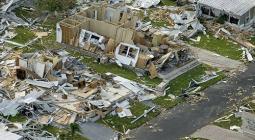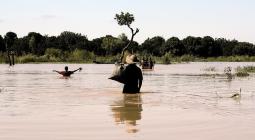Rich nations meet $100bn climate finance goal – two years late

For the first time, rich nations in 2022 delivered on a longstanding pledge to channel $100 billion a year in climate finance to developing nations – two years later than originally promised, official figures showed on Wednesday.
Their failure to meet the goal on time has been a sore point in the UN climate talks, fuelling distrust between wealthy governments and poorer countries, which have struggled to cover the cost of switching to cleaner energy and adapting to worsening climate change impacts.
According to the new data from the Organisation for Economic Co-operation and Development (OECD), developed countries provided and mobilised $115.9 billion in climate finance for developing countries in 2022, up from $89.6 billion in 2021.
OECD Secretary-General Mathias Cormann, a former Australian finance minister, said “exceeding” the annual commitment was “an important and symbolic achievement which goes some way towards making up for the two-year delay” and “should help build trust”.
The year-to-year increase of around 30% was the largest to date and was driven by significant funding increases from multilateral development banks – which contributed the most at $50.6 billion – individual governments and private finance mobilised by using public money to reduce investment risk.
Climate finance analysts criticised the quality of climate finance and the way the OECD calculates the figures.
Harjeet Singh, a veteran climate justice activist, said the process of providing and accounting for climate finance “is riddled with ambiguity and inadequacies” – a complaint long echoed by developing countries, which have called for more clarity and transparency on how the numbers are worked out.
“Much of the funding is repackaged as loans rather than grants and is often intertwined with existing aid, blurring the lines of true financial assistance,” said Singh.
The OECD report showed that in 2022, as in previous years, public climate finance mainly took the form of loans, which accounted for 69% or $63.6 billion. Not all of this lending was concessional, some was on market terms.
Grants, by contrast, made up just 28% of the total at $25.6 billion, with equity investments far smaller at $2.4 billion.
Development aid re-labelled?
Climate finance experts have also raised concerns over donor countries repurposing existing aid flows to meet the $100-billion target. A recent analysis by the Center for Global Development (CGD), a Washington-based think-tank, estimated that over a third of the money provided by developed countries in 2022 came from existing aid pots.
“A significant part of the increase is due to providers stretching, redirecting, and re-labelling existing development finance,” said Ian Mitchell, senior policy fellow at CGD and one of the report’s authors.
In February, an independent watchdog found the UK had counted an additional £1.7 billion ($2.15 billion) towards its £11.6-billion climate finance target without giving any more money to vulnerable countries, mainly by re-badging other forms of aid as it sought to counter fiscal pressures related to the COVID-19 pandemic.
The way in which climate finance contributions by donor countries are counted and tracked will be part of negotiations this year on a new finance goal set to be agreed at the COP29 climate summit in Azerbaijan in November.
The new collective quantified goal (NCQG) for finance is the most important decision expected to be taken at this year’s COP and will replace the current $100-billion commitment, due to expire in 2025.
Experts believe an ambitious deal can play a crucial role in getting developing countries, especially the poorest ones, to commit to stronger action on emissions and adaptation as they draft their new national climate plans due in early 2025.
US government backs the carbon credit industry’s push to fix itself
Melanie Robinson, global climate, economics and finance director at the World Resources Institute, said filling the funding gap for poorer nations should be “the top priority” for the NCQG negotiations at COP29 but success will hinge on more than just securing a much larger top-line dollar amount.
“For instance, it is crucial that the new climate finance goal ensures that funding is accessible and doesn’t burden developing countries with more unsustainable debt,” she said, calling for strong measures to report progress, hold countries accountable for meeting their obligations on time and boost the transparency of all climate finance.
‘Progress on adaptation finance’
Alongside simmering tensions over a push by wealthy nations to expand the pool of donor countries, and differing views on whether the new goal should include wider sources of climate finance, the most vulnerable countries have called for a specific target for adaptation funding.
Finance to help countries adapt their economies and societies to fiercer heatwaves, droughts, storms and floods, as well as rising seas, has always lagged far behind investment in clean energy and other measure to cut emissions – even as those climate impacts accelerate faster than scientists expected.
Loss and damage board speeds up work to allow countries direct access to funds
Under pressure at the COP26 climate talks in 2021, developed countries urged each other to at least double their provision of adaptation finance to developing nations by 2025 from the roughly $19 billion they gave in 2019.
This week, the OECD figures showed that at the halfway point in 2022, adaptation funding from developed nations rose to $28.9 billion – the highest ever – with an additional $3.5 billion mobilised from the private sector.
The Paris-based watchdog said progress towards meeting the target “has been made and needs to be maintained”.
Activist Singh said climate-vulnerable people and ecosystems needed rich nations to urgently step up and deliver “real, substantial financial support”.
“It’s not just about the numbers; it’s about integrity and genuine support,” he added. “As we stand today, the financial needs of developing countries for transitioning away from fossil fuels and dealing with climate impacts have skyrocketed into the trillions.”




